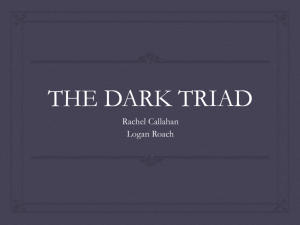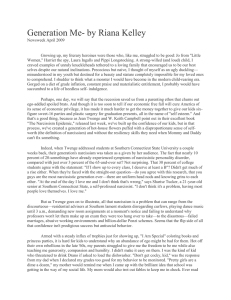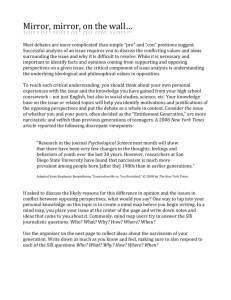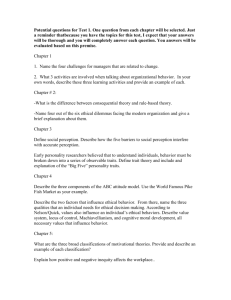Dark triad personality traits and theory of mind among school-age children 4 179
advertisement
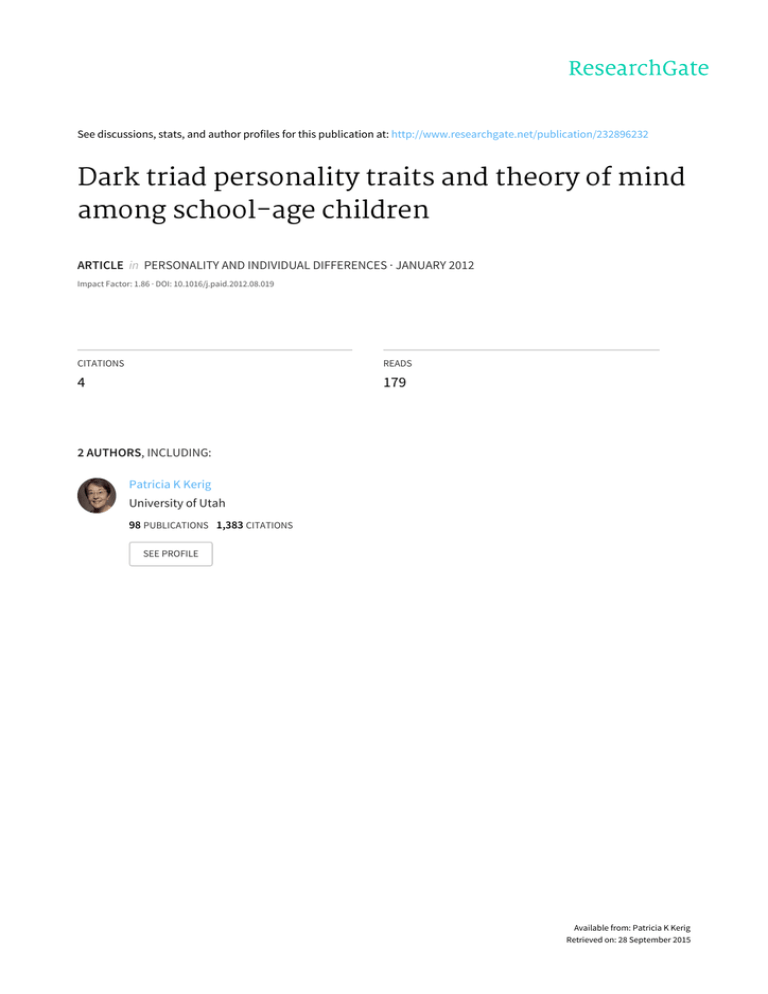
Seediscussions,stats,andauthorprofilesforthispublicationat:http://www.researchgate.net/publication/232896232 Darktriadpersonalitytraitsandtheoryofmind amongschool-agechildren ARTICLEinPERSONALITYANDINDIVIDUALDIFFERENCES·JANUARY2012 ImpactFactor:1.86·DOI:10.1016/j.paid.2012.08.019 CITATIONS READS 4 179 2AUTHORS,INCLUDING: PatriciaKKerig UniversityofUtah 98PUBLICATIONS1,383CITATIONS SEEPROFILE Availablefrom:PatriciaKKerig Retrievedon:28September2015 This article appeared in a journal published by Elsevier. The attached copy is furnished to the author for internal non-commercial research and education use, including for instruction at the authors institution and sharing with colleagues. Other uses, including reproduction and distribution, or selling or licensing copies, or posting to personal, institutional or third party websites are prohibited. In most cases authors are permitted to post their version of the article (e.g. in Word or Tex form) to their personal website or institutional repository. Authors requiring further information regarding Elsevier’s archiving and manuscript policies are encouraged to visit: http://www.elsevier.com/copyright Author's personal copy Personality and Individual Differences 54 (2013) 123–127 Contents lists available at SciVerse ScienceDirect Personality and Individual Differences journal homepage: www.elsevier.com/locate/paid Dark triad personality traits and theory of mind among school-age children Kurt K. Stellwagen a,⇑, Patricia K. Kerig b a b Department of Psychology, Eastern Washington University, United States Department of Psychology, University of Utah, United States a r t i c l e i n f o Article history: Received 15 May 2012 Received in revised form 7 August 2012 Accepted 16 August 2012 Available online 13 September 2012 Keywords: Theory of mind Dark triad Psychopathy Narcissism Machiavellianism Youth a b s t r a c t This study examined the associations between four personality dimensions associated with the dark triad (callous–unemotional traits, narcissism, impulsivity, and Machiavellianism) and theory of mind (TOM) abilities among 146 middle school children. Results of hierarchical multiple regression analyses showed narcissism to be positively associated with TOM, callous–unemotional (CU) traits to be negatively associated with TOM, and impulsivity and Machiavellianism to be unrelated to TOM. No significant interactions were found between gender and any of the dimensions of personality. The putative mechanisms linking each personality dimension with understanding of mental states in others are discussed, along with directions for future research. Ó 2012 Published by Elsevier Ltd. 1. Introduction The integration of the psychopathy construct into the developmental psychopathology of antisocial behavior has involved extending key elements of the syndrome from adulthood into childhood. One important contribution of this research has been the recognition that psychopathic traits (i.e., callous–unemotionality, impulsivity, and psychopathic narcissism) are associated with the development of the most severe and intractable conduct problems (e.g., Frick & Ellis, 1999). These findings suggest that studying the other two components of the so-called ‘‘dark triad’’ (Paulhus & Williams, 2002; Stellwagen, 2010) of personality—narcissism and Machiavellianism—might also increase our understanding of the dynamics of childhood antisocial behavior. Indeed, emerging research suggests that all three points of the dark triad are distinct constructs that are linked to aggressive behavior in children (e.g., Kerig & Stellwagen, 2010) and adults (e.g., Baughman, Dearing, Giammarco, & Vernon, 2012). A challenge confronting this new research agenda, however, is determining exactly how the personality dimensions that undergird the dark triad differ on theoretically important emotional and cognitive correlates. One such correlate is theory of mind (TOM), the ability to understand others as intentional agents and to predict and explain human behavior in terms ⇑ Corresponding author. Address: Department of Psychology, Eastern Washington University, Cheney, WA 99004, United States. Tel.: +1 509 359 7038; fax: +1 509 392 2220. E-mail address: kstellwagen@ewu.edu (K.K. Stellwagen). 0191-8869/$ - see front matter Ó 2012 Published by Elsevier Ltd. http://dx.doi.org/10.1016/j.paid.2012.08.019 of internal mental states (e.g., beliefs, desires, motivations, misconceptions). A better understanding of how TOM skills relate to dark triad personality traits in children could more clearly illuminate the social cognition that undergirds differing subtypes of antisocial behavior, thereby proving clinicians new directions for intervention early in the lifespan when such traits are more likely to be malleable. 2. Psychopathy as a multidimensional construct It is becoming clear that psychopathy is a multifaceted construct composed of interrelated subdimensions that demonstrate distinct patterns of association with relevant behavioral (e.g., Kerig & Stellwagen, 2010) and cognitive (Salekin, Neumann, Leistico, & Zalot, 2004) variables. For example, Frick and Hare (2001) widely used Antisocial Screening Device (APSD) yields three dimensions— impulsivity, callous–unemotional (CU) traits, and narcissism—each of which play an independent role in the emergence and expression of antisocial behavior. Impulsivity increases emotional reactivity and interpersonal sensitivity, decreases inhibitions against the violation of social norms, and reduces the tendency to carefully plan behavior (Frick & Hare, 2001). In contrast, CU traits—often described as the ‘‘hallmark characteristic’’ of psychopathy—are associated with insensitivity to punishment, a lack of remorse for misbehavior, and poor interpersonal attachments (Barry et al., 2000). Finally, psychopathy-linked narcissism is associated with the propensity to aggressively dominate others in the pursuit for power and prestige (Kerig & Stellwagen, 2010). Author's personal copy 124 K.K. Stellwagen, P.K. Kerig / Personality and Individual Differences 54 (2013) 123–127 3. Narcissism and Machiavellianism as distinct ‘‘points’’ on the dark triad Whereas all major models of psychopathy include narcissism as a key element (e.g., Cleckley, 1941; Frick & Hare, 2001; Hare, 2003) it is also clear that narcissistic traits can be identified in individuals that lack the predatory behaviors that help define psychopathy (e.g., Stellwagen, 2010). For example, whereas the APSD narcissism scale assesses the types of overtly dominant, grandiose behaviors that are specific to psychopathy-linked narcissism, Barry, Frick, and Killian (2003) developed a self-report measure of childhood narcissism, the Narcissistic Personality Inventory-Children (NPIC), that instead focuses on self-centered, vain attitudes. The NPIC is a downward extension of the ‘‘gold standard’’ measure of adult narcissism typically utilized by personality psychologists, the Narcissistic Personality Inventory (NPI; Raskin & Hall, 1979), and therefore is not conceptually related to psychopathy. Nevertheless, the NPIC provides a maladaptive narcissism subscale (comprising exploitiveness, entitlement, and exhibitionism) that is associated with conduct problems (Barry et al., 2003). The maladaptive subscale of the NPIC, therefore, is relevant to narcissism as a distinctive element of the dark triad of personality. Machiavellianism, the third point of the dark triad, refers to a cynical, deceptive and manipulative orientation that is associated with a lack of concern for conventional morality (Geis & Christie, 1970; Kerig & Sink, 2010). Whereas there is obviously some degree of conceptual overlap between psychopathy and Machiavellianism, the extant literature also indicates some important distinctions. For example, utilizing teacher reports, Kerig and Stellwagen (2010) examined the contributions of Machiavellianism and the factors of psychopathy to the prediction of several forms of childhood aggression. Results indicated that all three factors of psychopathy were associated with physical aggression, while Machiavellianism was unrelated to physical aggression but instead functioned as the strongest predictor of relational aggression. Thus, unlike the frankly overt aggression associated with psychopathy, Machiavellianism appears to be most relevant to the use of ‘‘sneaky’’, emotionally damaging behaviors that are less likely to draw negative attention to the perpetrator (Kerig & Sink, 2010). 4. Theory of mind and interpersonal exploitation Recent research in developmental psychology (e.g., Miller, 2012) has focused on theory of mind (TOM) abilities as the key precursor of human social skills, based upon the logic that children’s ability to impute relevant mental states such as presumptions, intentions, and desires underlies their ability to accurately anticipate and influence the behavior of others. TOM ability is best conceptualized as a neutral social instrument that enables both prosocial behaviors (resolving conflicts peacefully and cultivating friendships) and antisocial behaviors (e.g., interpersonal manipulation and deceitfulness). In fact, because TOM tasks often assess the ability to describe how false beliefs are created and how such beliefs subsequently influence behavior, the available measures are well suited to research that examines interpersonal exploitation (e.g., Sutton, Smith, & Swettenham, 1999). For example, research has shown that ringleader bullying is associated with TOM abilities (Stellwagen & Kerig, 2005; Sutton et al., 1999), suggesting that social acumen allows bullies to successfully manipulate victims, recruit followers, and hide their misbehavior. Moreover, a recent study that indicated that white collar criminals showed increased cortical thickening in multiple brain areas associated with TOM (Raine et al., 2011), indicates that theoretically important linkages between social acuity and antisocial behavior may extend across the lifespan. 5. Theory of mind and the dark triad Although some studies have failed to find an association between TOM abilities and psychopathy (e.g., Blair et al., 1996; Dolan & Fullam, 2004), prior investigations have utilized global psychopathy scores and have thus left unexplored the possibility that TOM ability may be differentially associated with the subdimensions of the syndrome. The associations among verbal intelligence and the subfactors of psychopathy have been examined in an adolescent population (e.g., Salekin et al., 2004), providing one template for how the dimensions of psychopathy could relate to TOM abilities. More specifically, Salekin and colleagues found that verbal intelligence was positively associated with narcissism, negatively associated with CU traits, and unrelated to impulsivity. Salekin and colleagues noted that their findings were consistent with Cleckley’s (1941) seminal case formulations of individuals demonstrating both socially intelligent behavior patterns and prominent psychopathic characteristics. However, whereas intelligence test scores provide some useful data for examining Cleckley’s theoretical formulations, intelligence tests focus on academic and analytic abilities and Cleckley’s description of psychopathic individuals with sophisticated interpersonal skills is most relevant to the concept of social or emotional intelligence. For example, Cleckley’s case examples included a con man described as having a ‘‘remarkable knowledge of other people and their reactions’’ (p. 39) and a petty criminal who avoided responsibility for his crimes through his ability to concoct ‘‘ingenious alibis’’ (p. 65). In essence, Cleckley described the typical psychopath as utilizing feigned honesty in the service of interpersonal manipulation and exploitation. Therefore, there is a need to examine the association between psychopathic traits and social skills utilizing a measure specifically designed to assess interpersonal acuity (e.g., a TOM instrument). Like psychopathy-linked narcissism, past research with the NPI (the adult self-report of self-aggrandizement) has indicated a positive association with intelligence (e.g., Paulhus & Williams, 2002), suggesting the possibility of a relatively robust relationship between intelligence and narcissism. If TOM performance is found to follow the same positive pattern of association with the differing measures of narcissism utilized in this study, this would reinforce Salekin and colleagues’ (2004) conclusion that grandiosity and selfimportance may be ‘‘kindled’’ by social cognition and mental abilities. This would further suggest that models of intervention for antisocial behavior that presuppose social skill deficiencies (e.g., McGinnis, 2011) may be a poor fit for children displaying narcissistic characteristics. Given that most (e.g., Geis & Moon, 1981)—although not all (e.g., O’Hair, Cody, & McLaughlin, 1981)—of the available research indicates that those high in Machiavellianism can effectively deceive and manipulate others, it is somewhat surprising that the small handful of studies conducted have failed to demonstrate a positive association between Machiavellianism and TOM in either children (e.g., Repacholi, Slaughter, Pritchard, & Gibbs, 2003; Slaughter, 2010) or adults (e.g., Lyons, Caldwell, & Schultz, 2010). The extant evidence, therefore, suggests that any competitive advantage associated with Machiavellianism results more from ruthlessness (Geis & Christie, 1970) than from superior social acuity. However, this conclusion should still be considered tentative given the paucity of studies that have assessed the association between Machiavellianism and TOM. 6. The present study Building upon prior research that showed that narcissism is associated with verbal intelligence (e.g., Paulhus & Williams, 2002; Salekin et al., 2004) and socially adept forms of antisocial Author's personal copy 125 K.K. Stellwagen, P.K. Kerig / Personality and Individual Differences 54 (2013) 123–127 behavior (Kerig & Stellwagen, 2010; Stellwagen & Kerig, 2005; Sutton et al., 1999), we hypothesized that TOM would be positively associated with both forms of narcissism assessed in the present study. Extrapolating from Salekin and colleagues’ (2004) findings we hypothesized that TOM would be negatively associated with CU traits and unrelated to impulsivity. Finally, because the few extant studies have failed to find an association between Machiavellianism and TOM among children (Repacholi et al., 2003; Slaughter, 2010), we likewise hypothesized that there would be no significant association between these variables in the present study. people’’), and exploitativeness (e.g., ‘‘It is easy to get people to do what I want’’). The NPIC utilizes a forced choice format, in which respondents choose either a statement that reflects a narcissistic attitude or preference (e.g., ‘‘I like to be the center of attention’’) or one that is not indicative of narcissism (e.g., ‘‘I like to blend in with other people around me’’). After choosing a response, respondents then rate the statement as a ‘‘really true’’ or ‘‘sort of true’’ indication of their attitude. Therefore, each item has a 4-point response range. In the present sample, the internal consistency of the maladaptive narcissism scale was 0.75. 7. Methods 7.3.4. Theory of mind (TOM) Eleven social stories were utilized to determine the ability of participants to make mental state attributions. Nine of these social stories were derived from the Advanced Test of Theory of Mind (ATTOM; Happé, 1994) while two stories were derived from Sutton and colleagues (1999). These two instruments were primarily chosen because both the ATTOM (Happé, Winner, & Brownell, 1998) and the Sutton measure (Sutton et al., 1999) have been successful in differentiating between groups of cognitively normal individuals—a rarity among theory of mind measures. Moreover, both measures require the respondent to explain the motivations that underlie various deceptive and surreptitious behaviors, a format that is well-suited to a study assessing the ‘‘darker’’ implications of TOM. Each of the 11 TOM stories was read to the respondents. After each story was read, comprehension questions were asked to determine whether or not the respondent had grasped the gist of each stories’ narrative. Narratives were repeated one time only for respondents who were unable to correctly answer a comprehension question. After the comprehension questions were completed, respondents were asked the actual TOM questions (i.e., the respondents were asked to describe the specific intentions and beliefs that motivated a character’s behavior). Two raters independently scored each protocol and disagreements were resolved by discussion. In the rare cases in which a scoring consensus could not be reached, the protocol was given to a third rater who ‘‘broke the tie’’. Levels of agreement for the eleven social stories were high ranging from 0.88 to 1.0, and the interrater reliability for the instrument as a whole was 0.96. The internal consistency of the measure was 0.82. 7.1. Participants Data were collected from a sample of 146 schoolchildren recruited from a Midwestern community. Among the participants, 16% were sixth-graders, 37% were seventh-graders, and 47% were eighth-graders. Fifty-eight percent of the sample was female and 42% was male. Consistent with the demographics of the community from which they were recruited, 82% were European American, 3% were African American, 1% were Latino/Latina, 1% were from other ethnic groups, and 13% declined to state their ethnicity. 7.2. Procedure The procedures and measures used in the present study were part of a larger study on children’s social behavior approved by the Miami University IRB. The research was conducted during the second half of the school year, and included only teachers who had known the students involved for a minimum of 3 months. Among the children eligible for participation in the study, 69% provided both parent consent and child assent, for an overall refusal rate of 31%. 7.3. Measures 7.3.1. Antisocial Process Screening Device—Teacher Report (APSD) Teachers rated children’s behaviors on dimensions associated with psychopathy on the 20-item APSD (Frick & Hare, 2001). Individual items on the APSD are scored on a three-point scale with 0 indicating not at all true, 1 indicating sometimes true, and 2 indicating definitely true. Factor analyses of the APSD have indicated a three-factor model that includes a five-item impulsivity subscale, a six-item callous–unemotional subscale, and a seven-item narcissism subscale (Frick, Bodin, & Barry, 2000). In the present sample, the internal consistencies were 0.80 for impulsivity, 0.77 for CU, and 0.89 for narcissism. 7.3.2. Machiavellian rating scale for young children Teachers also rated children’s behavior on this 12-item scale (Repacholi et al., 2003). Items were derived from adult measures of Machiavellianism and assess behaviors such as deceitfulness (e.g., ‘‘Lies if cornered’’), manipulativeness (e.g., ‘‘Is a flatterer’’), and unscrupulousness (e.g., ‘‘Will use any means to achieve what s/he wants’’). All items are rated on a 3-point scale with 1 indicating rarely applies, 2 indicating somewhat applies, and 3 indicating certainly applies. The internal consistency of the scale in the present sample was 0.84. 7.3.3. Narcissistic Personality Inventory for Children (NPIC) Study participants completed the 18 items on the NPIC (Barry et al., 2003) that comprise the maladaptive narcissism scale. This scale assesses exhibitionism (e.g., ‘‘I usually show off when I get the chance’’), entitlement (e.g., ‘‘I expect to get a lot from other 8. Results 8.1. Main effects for gender and grade A MANOVA indicated that there were overall mean differences related to child gender Wilks’ k (6, 120) = 6.15, p < 0.001, and grade, Wilks’ k (12, 240) = 2.76, p < 0.01. As reported in Table 1, follow-up univariate tests for gender indicated that boys were rated higher than girls on Machiavellianism and all three dimensions of psychopathy. Boys and girls achieved similar scores on the TOM instruTable 1 Means and standard deviations. Impulsivity Callous–unemotional traits Psychopathy-linked narcissism Maladaptive narcissism Machiavellianism Theory of mind * p < 0.05. p < 0.01. *** p < 0.001. ** Boys N = 61 Girls N = 85 M (SD) M (SD) 4.13 4.30 4.50 36.07 9.94 9.70 2.50 2.45 3.67 5.75 4.74 1.90 2.29 2.07 2.22 36.68 7.43 9.49 2.10 2.18 2.78 7.30 4.21 2.11 F (1, 144) 15.07*** 24.20*** 8.70** 0.04 4.90* 0.70 Author's personal copy 126 K.K. Stellwagen, P.K. Kerig / Personality and Individual Differences 54 (2013) 123–127 ment and on the self-report of maladaptive narcissism. Grade was used as an index of developmental level, given that youth who have been held back or accelerated academically would be more appropriately assigned to a cohort comprised of their grade level rather than their chronological age. Univariate tests for grade indicated that 6th graders were rated lowest in CU traits, F (2, 143) = 5.65, p < 0.01; Ms. (SDs) = 2.61 (2.52), 3.87 (2.42), 2.47 (2.49) for 6th, 7th, and 8th graders, respectively. No other effects for grade were found and there were no interactions between gender and grade. Table 3 Summary of regression analysis predicting TOM from dimensions of psychopathic traits. Variable Dependent variable: Antisocial Process Step 1 Gendera Grade Step 2 Impulsivity CU traits Psychopathy-linked narcissism 8.2. Intercorrelations Intercorrelations among impulsivity, CU traits, psychopathylinked narcissism, and Machiavellianism were all positive and significant for both sexes (see Table 2), consistent with previous research. On the other hand, maladaptive narcissism was unrelated to CU traits and impulsivity for all children but was positively correlated with psychopathy-linked narcissism for boys. Correlations between maladaptive narcissism and Machiavellianism were positive and significant for both sexes. For boys, TOM abilities were negatively and significantly correlated with CU traits and positively and significantly correlated with maladaptive narcissism. For girls, TOM was negatively and significantly correlated with CU traits. In all cases, the pattern of results did not differ significantly when boys and girls were directly compared utilizing Fisher’s r to z transformation. 8.3. Multiple regressions To account for the influence of gender, a series of moderated multiple regressions were conducted that included the cross product of gender and each independent variable (impulsivity, CU traits, psychopathy-linked narcissism, maladaptive narcissism, and Machiavellianism). In all cases, results indicated that gender did not function as a moderator; therefore, in the interest of streamlining the analysis and presentation of data, the results of these analyses are not reported. For the regression procedures reported below, we entered gender and grade level as covariates in the first step of the regression procedures. Based upon the logic that psychopathy is best conceptualized as a multidimensional construct composed of distinct yet interrelated factors, in the first regression procedure the three dimensions of psychopathy were entered simultaneously. Next, we assessed the second component of the dark triad (narcissism) in a separate multiple regression procedure. Finally, in the third multiple regression procedure we independently assessed the last remaining component of the dark triad (Machiavellianism). As seen in Table 3, over and above any influence associated with the covariates—and controlling for the influence of the other Table 2 Intercorrelations. 1 1. Impulsivity 2. Callous– unemotional traits 3. Psychopathylinked narcissism 4. Maladaptive narcissism 5. Machiavellianism 6. Theory of Mind 2 3 4 5 6 – 0.53** 0.52** – 0.74** 0.50** 0.10 0.03 0.67** 0.58** 0.08 0.30* 0.62** 0.45** – 0.30** 0.69** 0.06 * 0.11 0.04 0.19 – 0.31 0.29* 0.55** 0.09 0.58** 0.39** 0.68** 0.05 0.24* 0.12 – 0.12 0.01 – Note: N for boys = 61; N for girls = 85. Correlations for boys are displayed in plain text above the diagonal; correlations for girls are displayed in italics below the diagonal. * p < 0.05. ** p < 0.01. B SE B DR2 b Screening Device scale scores 0.02 0.34 0.38 0.37 0.25 0.08 0.14 0.05 0.41 0.19 0.10 0.08 0.07 0.06 0.52** 0.32** Dependent variable: Maladaptive narcissism Step 2 Maladaptive narcissism 0.05 0.03 0.18* Dependent variable: Machiavellianism Step 2 Machiavellianism 0.03 0.04 0.06 0.19** 0.03* 0.00 a 1 = Male; 2 = female. p < 0.05. ** p < 0.01. * dimensions of psychopathy—CU traits had a negative and significant association with TOM abilities whereas psychopathy-linked narcissism had a positive and significant association. These results diverged from the correlational analyses that showed no significant bivariate relationship between psychopathy-linked narcissism and TOM, suggesting that psychopathy-linked narcissism is associated with TOM in its ‘‘pure’’ form (e.g., after any shared variance with CU traits is removed from the equation). Further, maladaptive narcissism was significantly and positively associated with TOM whereas Machiavellianism and impulsivity were unrelated to TOM. 9. Discussion The present study supports the conclusion that investigating the relations between TOM and psychopathy requires adopting a multifaceted view of the psychopathy construct. The different facets of the APSD all demonstrated unique associations with TOM, which ranged from those that were significant and positive (psychopathy-linked narcissism) to significant and negative (CU traits), to non-significant (impulsivity). Similarly, whereas the dark triad personality types were all highly interrelated, the results of this study indicate that they do not function as simple analogs of one another in relation to children’s TOM abilities. In summary, the results of this study suggest that the dark triad constructs are indeed best conceptualized as distinct yet overlapping sets of personality traits (Paulhus & Williams, 2002; Stellwagen, 2010). The finding that callous–unemotional traits were associated with poor TOM skills among children suggests that the development of compassion—the inverse of callousness—may depend upon the ability to first see the world through the eyes of others. Utilizing a bidirectional framework, it could also be argued that individuals with a neurological propensity to low levels affective arousal are naturally callous (Kochanska, 1997) and therefore simply uninterested in deciphering the internal motivations of others. Future research might investigate whether a shared neuropsychological deficit underlies both CU traits (Viding, 2004) and poor TOM abilities (Abu-Akel, 2003). The positive association between narcissism and TOM found in the present study might suggest that entitled, self-enhancing children carefully observe their social environments and thereby cultivate their TOM skills in the service of increasing their interpersonal status and dominance (e.g., winning friends, joining an influential clique, creating a powerful reputation). Another possibility is that children with innately strong TOM skills develop high self-regard in the wake of their interpersonal successes. Of course, these Author's personal copy K.K. Stellwagen, P.K. Kerig / Personality and Individual Differences 54 (2013) 123–127 explanations are not mutually exclusive. For example, children with inherently strong TOM skills may achieve interpersonal success naturally but also find that retaining an elite social status requires continually sharpening their TOM skills over time. In any event, our findings suggest that it is indeed the narcissism dimension of psychopathy that is most relevant to Cleckley’s formulation that psychopathic traits and social adept behaviors are linked. Moreover, our findings dovetail with Cleckley’s case descriptions which are replete with descriptions of ‘‘haughty’’, ‘‘pompous’’, ‘‘condescending’’, and ‘‘supercilious’’ individuals. As noted above, whereas much of the extant research has indicated that individuals high in Machiavellianism are effective manipulators, previous research has failed to demonstrate a positive relationship between TOM and Machiavellianism (e.g., Repacholi et al., 2003; Slaughter, 2010). Similarly, the results of the present study failed to find significant links between Machiavellianism and TOM. However, there are potential explanations for this paradox. For example, in the absence of superior social acuity, ethically and emotionally detached youth might still hold a competitive advantage over their non-Machiavellian counterparts who are concerned about ‘‘playing fair’’, compromising, demonstrating compassion, and being liked. In essence, this is the explanation Geis and Christie (1970) used for explaining the ability of those high in Machiavellianism to manipulate and outperform their peers in a competitive laboratory paradigm. That is, social acuity may actually act as a handicap for the individual low in Machiavellianism in a competitive interpersonal situation, whereas the youth high in Machiavellianism exclusively utilizes his or her social acuity to gain an advantage. This view is consistent with Kerig and Stellwagen’s (2010) finding that Machiavellianism is associated with relational aggression, given that relational aggression involves manipulating the social hierarchy to damage the reputation of another. 10. Limitations and directions for future research One important limitation of the present study is the lack of ethnic diversity in the sample, suggesting that these findings should only be generalized beyond white suburban US populations with caution. A second limitation is that the cross-sectional design of the present study does not allow for causal interpretations of the results or the identification of developmental pathways. Future research examining the association between TOM skills and dark triad personality traits would benefit from prospective longitudinal designs. Finally, because this was a normative sample, few youth scored at the top of the possible range on the instruments assessing dark triad personality traits. Frick and Hare (2001) have suggested that some of the effects associated with psychopathy only manifest among those who score at or above the 95th percentile and, therefore, it would be valuable to replicate this study with a larger and more antisocial sample. To evaluate the robustness of our findings, it will be important to replicate these results utilizing different measures—and/or different respondents—for assessing psychopathy, narcissism, and Machiavellianism. For example, the APSD can also be completed via a parent report and/or a self-report, thereby providing additional perspectives of a target child’s behavioral and emotional functioning. Similarly, Machiavellianism in youth can be evaluated using a self-report measure (Geis & Christie, 1970) a response format that is well suited for gathering information regarding the attitudinal features of the construct. References Abu-Akel, A. (2003). A neurobiological mapping of theory of mind. Brain Research Reviews, 43, 29–40. 127 Barry, C. T., Frick, P. J., Deshazo, T. M., McCoy, M. G., Ellis, M., & Loney, B. R. (2000). The importance of callous–unemotional traits for extending the concept of psychopathy to children. Journal of Abnormal Psychology, 109, 335–340. Barry, C. T., Frick, P. J., & Killian, A. L. (2003). The relation of narcissism to selfesteem to conduct problems in children: A preliminary investigation. Journal of Clinical Child and Adolescent Psychology, 32, 139–152. Baughman, H. M., Dearing, S., Giammarco, E., & Vernon, P. A. (2012). Relationships between bullying behaviours and the dark triad: A study with adults. Personality and Individual Differences, 52, 571–575. Blair, R. J., Sellars, C., Strickland, I., Clark, F., Williams, A. O., Smith, M., et al. (1996). Theory of mind in the psychopath. Journal of Forensic Psychiatry, 7, 15–25. Cleckley, H. (1941). The mask of sanity. St Louis, MO: Mosby. Dolan, M., & Fullam, R. (2004). Theory of mind and mentalization ability in antisocial personality disorder with and without psychopathy. Psychological Medicine, 34, 1093–1102. Frick, P. J., Bodin, S. D., & Barry, C. T. (2000). Psychopathic traits and conduct problems in community and clinic-referred samples of children: Further development of the psychopathy screening device. Psychological Assessment, 12, 382–393. Frick, P. J., & Ellis, M. (1999). Callous–unemotional traits and subtypes of conduct disorder. Clinical Child and Family Psychology Review, 2, 149–168. Frick, P. J., & Hare, R. D. (2001). The Antisocial Process Screening Device (APSD). Toronto, Canada: Multi-Health Systems. Geis, F. L., & Christie, R. (1970). Overview of experimental research. In R. Christie & F. L. Geis (Eds.), Studies in Machiavellianism (pp. 285–313). NY: Academic Press. Geis, F. L., & Moon, T. H. (1981). Machiavellianism and deception. Journal of Personality and Social Psychology, 41, 766–775. Happé, F. (1994). An advanced test of theory of mind: Understanding of story characters thoughts and feelings by able autistic, mentally handicapped, and normal children and adults. Journal of Autism and Developmental Disorders, 14, 385–389. Happé, F., Winner, E., & Brownell, H. (1998). The getting of wisdom: Theory of mind in old age. Developmental Psychology, 34, 358–362. Hare, R. D. (2003). Manual for the revised psychopathy checklist (2nd ed.). Toronto, ON, Canada: Multi-Health Systems. Kerig, P. K., & Sink, H. E. (2010). The new scoundrel on the schoolyard: Contributions of Machiavellianism to the understanding of youth aggression. In C. T. Barry, P. K. Kerig, K. K. Stellwagen, & T. D. Barry (Eds.), Narcissism and Machiavellianism in youth (pp. 193–212). Washington, DC: APA Press. Kerig, P. K., & Stellwagen, K. K. (2010). Roles of callous–unemotional traits, narcissism, and Machiavellianism in childhood aggression. Journal of Psychopathology and Behavioral Assessment, 32, 343–352. Kochanska, G. (1997). Multiple pathways to conscience for children with different temperaments from toddlerhood to age 5. Developmental Psychology, 33, 228–240. Lyons, M., Caldwell, T., & Schultz, S. (2010). Mind-reading and manipulation – Is Machiavellianism related to theory of mind? Journal of Evolutionary Psychology, 8, 261–274. McGinnis, E. (2011). Skill-streaming the elementary school child. Champaign, IL: Research Press. Miller, S. A. (2012). Theory of mind: Beyond the preschool years. NY: Psychology Press. O’Hair, H. D., Cody, M. J., & McLaughlin, M. L. (1981). Prepared lies, spontaneous lies, Machiavellianism, and nonverbal communication. Human Communication Research, 7, 325–339. Paulhus, D. L., & Williams, K. M. (2002). The dark triad of personality: Narcissism, Machiavellianism and psychopathy. Journal of Research in Personality, 36, 556–563. Raine, A., Laufer, W. S., Yang, Y., Narr, K. L., Thompson, P., & Toga, A. W. (2011). Increased executive functioning, attention, and cortical thickness in whitecollar criminals. Human Brain Mapping. http://dx.doi.org/10.1002/hbm.21415. Raskin, R. N., & Hall, C. S. (1979). A narcissistic personality inventory. Psychological Reports, 45, 590. Repacholi, B., Slaughter, V., Pritchard, M., & Gibbs, V. (2003). Theory of mind, Machiavellianism, and social functioning in childhood. In B. Repacholi & V. Slaughter (Eds.), Individual differences in theory of mind (pp. 67–97). NY: Psychology Press. Salekin, R. T., Neumann, C. S., Leistico, A. M., & Zalot, A. A. (2004). Psychopathy in youth and intelligence. An investigation of Cleckley’s hypothesis. Journal of Clinical Child and Adolescent Psychology, 33, 731–742. Slaughter, V. (2010). Early adoption of Machiavellian attitudes: Implications for children’s interpersonal relationships. In C. T. Barry, P. K. Kerig, K. K. Stellwagen, & T. D. Barry (Eds.), Narcissism and Machiavellianism in youth (pp. 25–45). Washington, DC: APA Press. Stellwagen, K. K., & Kerig, P. K. (2005). Investigating subtypes of childhood aggression: Links to theory of mind, psychopathic personality traits, and emotional dysregulation. In Poster presented at the annual meeting of the American Psychological Association in Washington, DC. Stellwagen, K. K. (2010). Psychopathy, narcissism, and Machiavellianism: Distinct yet intertwining personality constructs. In C. T. Barry, P. K. Kerig, K. K. Stellwagen, & T. D. Barry (Eds.), Narcissism and Machiavellianism in youth (pp. 25–45). Washington, DC: APA Press. Sutton, J., Smith, P. K., & Swettenham, J. (1999). Social cognition and bullying: Social inadequacy or skilled manipulation? British Journal of Developmental Psychology, 17, 435–450. Viding, E. (2004). Annotation: Understanding the development of psychopathy. Journal of Child Psychology and Psychiatry, 45, 1329–1337.
